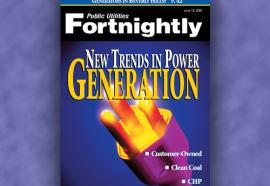IPP
CO2 Does Not Pollute: But Kyoto's Demise Won't End Debate
Money, Power and Trade: What You Never Knew About the Western Energy Crisis
Fortnightly
People
Mexico, Cuba: Next Hot Spots for Energy?
Both look overseas for project developers, but some U.S. firms worry they'll miss out.
News Digest
Mergers & Acquisitions
NSP + New Century. The Federal Energy Regulatory Commission OK'd the merger of Northern States Power Co. (NSP) and New Century Energies Inc. (NCE), to form Xcel Energy Inc., on condition that the new company would join the Midwest Independent System Operator. FERC Docket No. EC99-101- 000, Jan. 12, 2000, 90 FERC ¶61,020.
* Rate Pancaking. The FERC found no problem with transmission rate pancaking with the MISO condition, even though NCE subsidiary Southwestern Public Service Co. (SPS) belongs to the rival Southwest Power Pool.
Fuel for Thought: Some Questions on the Future of Gas-Fired Generation
An industry booster looks at the forecasts for price and technology and sees some big "ifs" for modular, on-site and distributed applications.
I'm a believer from way back in using natural gas for modular, on-site and distributed generation. But I worry that we might be overselling it.
Certainly, the idea of a natural gas fuel cell in every home basement needs careful examination. Add to that the notion that we can replace much of our commercial power demand with gas-fired systems such as fuel cells and microturbines.
Keys for Success in Power Plant Investing
It's not as straightforward as it seems, says an industry veteran.
No one can foresee with a high degree of certainty how electric energy markets will be structured over the long-term. The changes facing the electric energy industry may be as profound as those upheavals we've seen in the airline industry during the past two decades. In the "good old days," a flight from New York to Chicago had one price and an electric generating plant had a regulated price for each kilowatt-hour produced.
Perspective
ANYONE AT ALL CLOSE TO the securitization scene agrees on at least one thing: The referenda in California and Massachusetts seeking to roll back restructuring have cast such a pall over the bond issues put out late last year by the California electric utilities to finance their stranded costs that any new issuer hoping for the same 'AAA' rating may as well get prepared to sacrifice his or her firstborn to the rating agencies.
Exploiting the Random Nature of Transmission Capacity
SEVERAL YEARS AGO, ENGINEERS AT AMERICAN ELECTRIC Power measured the transfer capability or transmission capacity (in this article we will use the terms interchangeably) between AEP and Commonwealth Edison. Using traditional methods, they found that the winter transmission capacity that year was 3,500 megawatts.
Then they performed a more exhaustive and nonstandard analysis. It showed that during the month of January, transmission capacity actually varied from a low of 1,600 MW (less than half the nominal amount) to a high of 6,000 MW (70 percent higher than nominal).


